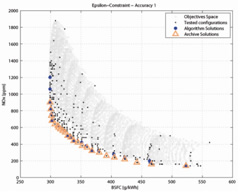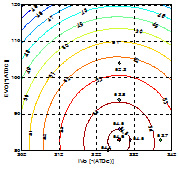Multi-objective optimization
The high number of interacting parameters, which need to be defined, from a very early stage of design of a modern engine, entails the use of efficient multiple objective optimization strategies. The one factor at a time approach is no longer sustainable, not only in the definition of the different configurations which can be tested experimentally, but also in the use of the thermo-fluid dynamic codes which currently play a fundamental role in the design and optimization of any new engine system.
 An optimization process typically entails the employment of a three-step methodology: a Design of Experiments method to explore the design space, a response surface to estimate a possible optimal
point and finer optimization algorithm to determine the best solution. For what concerns the employment of fine optimization techniques, three relevant classes of solution approaches can be
addressed, namely: relaxation methods, search heuristics and generalized pattern search methods. Classical gradient-based or Newton-based methods are generally not suitable for internal
combustion engine optimization problems and, if applied, their strong dependence on the initial guess, might cause them to find local optima rather than global ones.
An optimization process typically entails the employment of a three-step methodology: a Design of Experiments method to explore the design space, a response surface to estimate a possible optimal
point and finer optimization algorithm to determine the best solution. For what concerns the employment of fine optimization techniques, three relevant classes of solution approaches can be
addressed, namely: relaxation methods, search heuristics and generalized pattern search methods. Classical gradient-based or Newton-based methods are generally not suitable for internal
combustion engine optimization problems and, if applied, their strong dependence on the initial guess, might cause them to find local optima rather than global ones.
 In recent studies performed by
the research group the Mesh-Adaptive Direct Search (MADS) method was employed for single-objective problems (typically performance optimization), while Genetic Algorithms proved to more
suitable and efficient in the case of multi-objective optimization problems (i.e. NOx-fuel consumption Pareto front).
In recent studies performed by
the research group the Mesh-Adaptive Direct Search (MADS) method was employed for single-objective problems (typically performance optimization), while Genetic Algorithms proved to more
suitable and efficient in the case of multi-objective optimization problems (i.e. NOx-fuel consumption Pareto front).
A Dedicated GUI has also been developed to simply the definition of most common optimization problems for engine applications.
Publications:
1 - G. D'Errico, T. Cerri, Application of Derivative-Free Search Algorithms for Performance Optimization of Spark Ignition Engines,
SAE Int. Congress & Exp. (Detroit, Michigan), April 14-17, 2008, paper n. 2008-01-0354.








